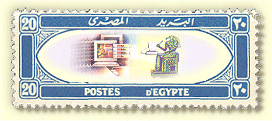

| Report of Meeting, July 9, 2011 |
|
PRESENT: John Sears (President), Peter Andrews (Chairman), Stanley Horesh (Deputy Chairman), Mike Murphy (Secretary), Brian Sedgley (Treasurer), John Davis (Librarian), David Sedgwick (Publicity), Mike Bramwell, John Clarke, Cyril Defriez, Ted Fraser-Smith, Peter Grech, Paul Green. Guest: Ann Sedgwick. APOLOGIES: Apologies for absence were received from: Edmund Hall (Editor/Webmaster), Sami Sadek (Committee), Margaret Chadwick, Angela Child, Pauline Gittoes, Mostafa El-Dars. The Chairman welcomed members present, and spoke initially about the forthcoming study meeting on TPOs at Stampex on September 17, when we shall update Peter Smith's 1983 book The Travelling Post Offices of Egypt (now on our website). He urged all members to bring to the meeting or to submit illustrations of TPO markings outside the dates of those mentioned in the book, or of different routes for known handstamp types, or of new or variant handstamp types. He emphasised that it was important that submissions should be classified according to the Smith type numbers. He noted that it would soon be time to settle the meetings programme for 2012, and appealed to members to consider their collections and to volunteer a talk - perhaps of half a meeting - on a topic of interest. It was astonishing, he said, how often half a dozen rarely-considered and rarely aired pages could prove fascinating when shown to colleagues to whom their content was novel and unfamiliar. The Secretary reinforced mention of the study meeting by thanking Edmund Hall (ESC 239) for his hard work in putting the book on the website, and announced two more website advances of interest: Two of our members, Omar Wassef (ESC 623) of Texas and Volker Kleiner (ESC 660) of Germany, have combined to present a full website about Egypt's Interpostals at www.interpostals.com. A non-member in South Africa, Wobbe Vegter, has put his exhibition display of Egyptian cassette envelopes online at wvegter.hivemind.net, and would very much welcome members' comments. The Secretary then mentioned two queries from members, which will appear in the QC and on the website, together with a response to one of them already supplied by Peter Grech (ESC 266). The President announced that Tony Chisholm (ESC 288), our Antipodes Agent, was about to visit from New Zealand, and invited all members and partners to luncheon at his home to meet Mr and Mrs Chisholm on Thursday August 18 Turning to the Auction, the President again appealed for volunteers to help in the future. Auction 50 will take place in the autumn under the present team, but after that the fate of its continuing is very much in doubt. Without an auction Circle funds will certainly suffer. On the nomination of our Egypt Agent, Dr Ibrahim Shoukry, a new member was elected from Cairo: Welcome, Mohamed Ashraf Nasr. And so it was on to the meeting, with John Davis (ESC 213) displaying his Hotels collection. This is a popular area of collecting, but John did not confine himself merely to the rather better known hotels containing Postal Department postal desks. He opened his display with a stunning 1856 cover rated 1s 6d from Samuel Shepheard acting as a forwarding agent from his British Hotel in Ezbekieh; it bears the elusive oval handstamp: Forwarded by / S.Shepheard / British Hotel / Cairo; only months later another Shepheard letter, to his wife in Leamington Spa, carries the headed emblem Shepheards / Hotel / Cairo. 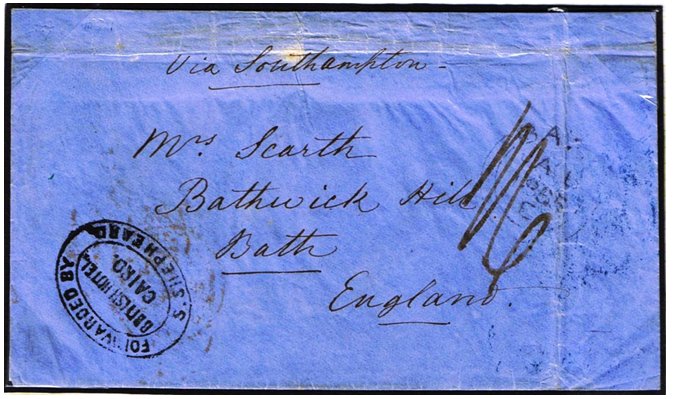 Then it was on to the Ghesireh Palace, built for Empress Eugenie for the opening of the Suez Canal in 1869, and the Mena House, at the foot of the Pyramids and home to many Hollywood stars as well as kings and queens. The Nile Hilton, a recent addition in1959 (and now sold off to be renovated), featured on a 10-mills stamp with the first-day handstamp reading Hilton Nile rather than Nile Holton. Though the Heliopolis Palace was opened in the 1930s, it had no post office until two decades later, and John showed one of the real rarities - a cover with the Heliopolis Palace / C handstamp. Only three are recorded, all in October 1955. The Savoy Hotel and the new (1906) Semiramis (now the Semiramis Inter-Continental) completed the first section of the talk, followed by the world's most famous hotel, Shepheards. 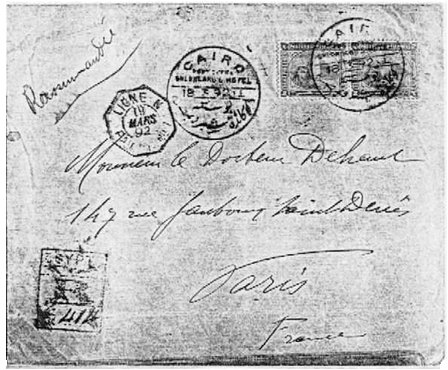 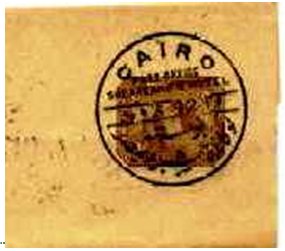 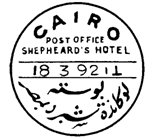 Boulad's type example, and the eBay version, CTO on a wrapper John showed ten different handstamps on 20 sheets, but the topic of HS2 was raised - and considerable doubt about whether there was any such type. The original was recorded by Jean Boulad, who reported three examples between 27 12 (18)91 and 15 6 97 with the month indicator as a "roman" (ie European) numeral - but other sightings have been rare indeed. Here is a CTO version that MAY be HS2, spotted on eBay. If anyone has a clear datestamp, the Circle would be delighted to see it. After the Ezbekieh Shepheard's was burned by the mob in 1952 a new hotel rose on the Nile bank, but with a machine canceller instead of handstamps. Recorded in red, violet and blue. The Sheraton was the most recent Cairo Hotel to have a handstamp, two of them in fact from 1970 to 1978 before machine cancellers took over ... and so to Alexandria, where only one hotel, the imposing Casino San Stefano (also now demolished and replaced by concrete and glass), had its own postmarks. There is les mail from here than other hotels, partly because visitors would head up the Nile, using Alexandria only for transit. In Luxor, however, there were tourists aplenty and at least two top-class hotels, the Luxor and the Winter Palace, to serve them. Both had neatly designed stationery and several datestamps, those struck in blue being given "a" numbers. Further up river, Aswan also had two world-standard hotels, the Cataract and the Savoy, the one looking out on Elephantine Island, the other originally at the island's northern tip. The Cataract continues strong today, but evidence for the Savoy, believed to have burned down in 1914, is vehemently denied by local people who know only the luxurious Oberoi that has replaced it. Moving away from the well-known hotels, John then showed a fascinating display of postal stationery from myriad hotels up and down the country which had no post office but were eager to advertise themselves on every outgoing letter. John has enjoyed tracking down examples of as many as possible, based on the listing sin the 1908 edition of Baedeker. Many of those were in the health resort of Helwan, just south of Cairo, which seems to have been particularly frequented by German guests according to the examples shown, but overall John has managed to form a fascinating collection from no fewer than 37 of these publicity-hungry hotels! On behalf of the members, Mike Murphy (ESC 240) thanked John warmly for his wide-ranging and enticing collection, adding that although he had collected Hotels for years, the afternoon had produced many items unknown to him. Members showed their appreciation in time-honoured fashion. |
|
|